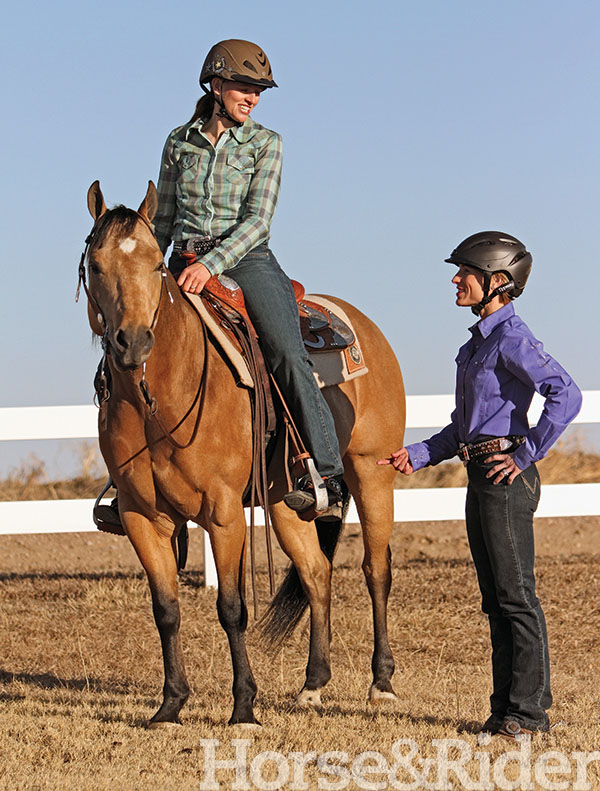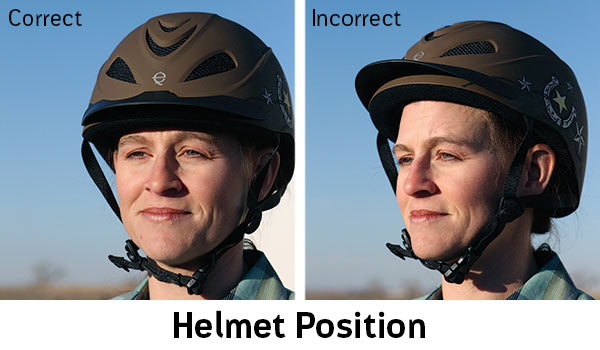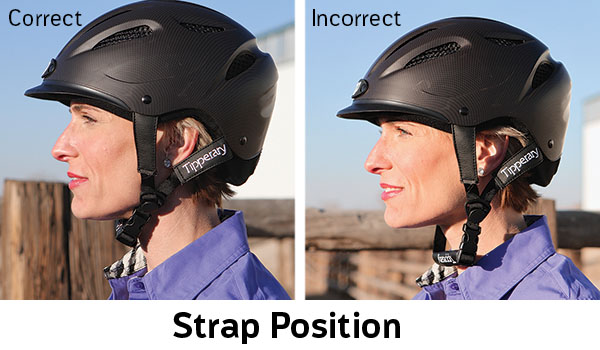How do I know what size to get? What do the different price ranges mean? What styles and features are available for my discipline? Choosing a protective riding helmet isn’t as simple as it used to be, but that means that you, as the buyer, now have many more options.
[READ: Helmet Care Tips]

And that’s where we come in. To help you sort through all the questions and find the right helmet, we talked with experts from Tipperary Equestrian and Troxel Helmets, as well as horse trainer and helmet advocate Julie Goodnight. Their advice will help you find a properly fitting helmet that you’ll want to wear.
Keep in Mind…
The very first thing to consider is that the helmet is certified by both the American Society for Testing and Materials (ASTM) and by the Safety Equipment Institute (SEI).
“Look inside the helmet for an SEI or ASTM label that shows the helmet has passed standards. That ensures a certain level of protection,” says Karisa Dern, marketing director at Troxel Helmets.
You also can visit ASTM’s Web site, astm.org, and SEI’s Web site, seinet.org, to look up all certified helmets, suggests Caitlin McConnell, marketing manager at Tipperary Equestrian.
“Do your research and see what helmet reviewers and users are talking about. Find out how much they like a specific helmet and why they like it,” she adds.
Once you’ve determined that the helmet is certified, it’s time to start considering size, price, and style, and then start trying out different models.
The best place to start your helmet search is at a horse expo, recommends Goodnight. There, you’ll be able to try on multiple brands, sizes, and styles. Also, it’s best if you can have someone knowledgeable help you fit the helmet.
Here are some other quick tips that’ll make trying on helmets easier. Both Dern and McConnell suggest wearing your hair the way you would when you ride (e.g. if it’s long, pull it back in a low ponytail).
Goodnight also advises to have your hair at its thickest when you go shopping. That way you know the helmet won’t be too tight in the future.
It’s also important to know the proper way to put the helmet on, says McConnell.
“When you try on a helmet for the first time, always, always fit the helmet by placing the front of it onto your forehead first, and then slide it down and back over the crown of your head,” she stresses. This is key to finding the right fit.
Sizing and Fit
Tipperary Equestrian (phoenixperformance.com) and Troxel Helmets (troxelhelmets.com) both offer sizing charts on their Web sites.
“Using a fitting chart helps you narrow down which helmet sizes you might be, and then you can start sampling helmets to see how they feel,” says Dern.
However, there’s more to a correct fit than just the helmet size.
Head shape: “I always tell people it’s kind of like buying a pair of shoes. Not every pair on the shelf is going to fit. People’s heads are the same way,” says Goodnight.
“Generally, people tend to have either a round or oval head.”
Usually, you can tell what head shape you have by where you feel pressure from the helmet, adds McConnell.
“Consider where the helmet is pinching. Is it the forehead? On your temples? If it’s pinching your forehead, you probably have a more oval-shaped head. If there’s pinching on the temples, you may have a rounder head. So look for a helmet that best suits your shape,” she explains.
Once you’ve found the type that suits your head’s shape, these are some other considerations to keep in mind.
How it should feel: “If it fits snugly on your head, without strapping it on, and you can shake your head and move it back and forth, without the helmet moving, that’s a good sign,” says Goodnight. “Leave it on long enough to get a feel for it.”
“Wear it around the store. If it gives you a headache, it’s too tight,” Dern recommends. “It should become less noticeable and more comfortable as you wear it.”
Dern, Goodnight, and McConnell all agree that when you rock the helmet forward and back, your eyebrows and skin should move with it. That’s a good sign of a snug fit.
“Here’s a good analogy: ‘Does it feel like some-one’s giving you a hug?’” says McConnell. “It should be an equal, all-around pressure that feels like someone’s hugging you, versus pinching you.”
“After finding a snug helmet, engage the features like the fit systems or adjustable padding to customize the fit,” Dern recommends.
If the helmet feels right, look at yourself in a mirror.

How it should look: “The helmet should sit level on your head, covering your forehead, and the visor’s brim should be about 1 inch, or the width of two fingers, above your eyebrow line,” says Dern.

“The brim should be parallel to the ground, so it’s not sitting back on your head or tilted forward,” adds Goodnight.
Lastly, buckle up the helmet’s straps.
“The chin strap should fit snugly, allowing only two fingers to be placed between your chin and the straps,” says Dern. “Where the front and back straps meet and where the slide is should be directly below your ear.”
Don’t think you’ll ‘grow into it’: One of the most common mistakes people make when choosing a helmet is buying one that’s too big.
“Don’t buy a too-large helmet in the hopes that it’ll fit next year. You need a helmet that fits well now,” stresses Dern. “A head can be fully grown at 10 to 14 years of age.”
And a loose helmet is a safety risk.
“If you have a fall, that helmet isn’t properly protecting you. It could easily rock forward and come off your head, and it won’t protect you the same way a correctly fitted helmet would,” McConnell warns.
Pricing, Styles, Features
Helmets can vary widely in price, so it’s good to know what styles and features are important for you, your climate, and your type of riding.
“All certified equestrian helmets go through the same certification process,” says Goodnight. “They all meet or exceed the requirements. A $39.95 helmet has the same safety value as a $400 helmet; it just doesn’t have all the bells and whistles. You’re paying for more style, comfort, and features.”
“Spending more might get you different padding or fancier styling or materials, but it doesn’t translate into advanced protection,” agrees Dern.
Ventilation: First, consider where you do most of your riding. If the weather can be hot and humid, a good ventilation system might be a priority for you. Also think about a lighter color that will stay cooler, says McConnell.
“If you’re in a colder climate, you might want something with less venting that has an interchangeable liner that allows you to add a winter liner into it,” she adds.
Materials: “There are a lot of different helmets made with many materials,” McConnell says. Before, the only style made was just a velvet-lined helmet with a plastic inner shell. Now, there are helmets done in moleskin, velvet, rubberized plastic, harder plastic, etc.”
Some materials, like leather and rugged nylon webbing, reflect the Western look, adds Dern.
Styles and colors: According to McConnell, many fun and creative colors are available, and she adds that the Sportage helmet is available in brown, black, blue, grey, and pink.

Troxel offers a Western line of helmets with available options in brown, black, and tan. The company also offers a variety of colors like pink, purple, green, and blue in their all-purpose helmets.
So with all of those choices, how do you find the right color for you? If it’s just for schooling or trail riding, go with what makes you happy.
If you’d want to wear it in the show pen, Goodnight has suggestions.
“When it comes to showing, find something that has a Western look to it and that fits in with your colors and outfit. I use the same judgment as when I’m picking out a cowboy hat. I make sure it’s stylish, the right color for me, and matches my outfit.”
“The new Rebel series features a choice of three Western graphics and a low-profile silhouette to appeal to Western riders and competitors,” adds Dern.
If style doesn’t seem important to you, Goodnight has a logical way of looking at it. “If the helmet is ugly, you’re not going to wear it.”
Just make sure that the style and color you choose is approved by your breed or sport organization.
Customize it: If you don’t find exactly what you’re looking for, consider customizing a more basic helmet to add your own personal flair.
Along with choosing fun colors, people are customizing their helmets by adding bling, decals, and stickers, says McConnell.
“One of our riders from the Young Riders’ Championship actually took the Sportage helmet to a car detailer. The rider is from Guatemala, and he had the Guatemalan flag detailed all over the helmet,” shares McConnell.
The opportunities to find the perfect helmet for you really are endless.







